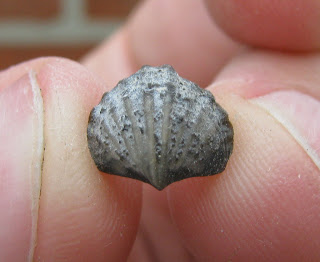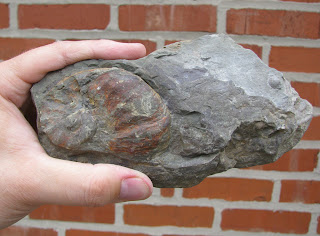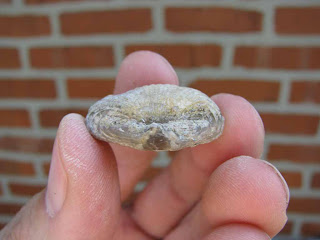Pustulatia pustulosa is a new brachiopod species for me. I found about a dozen specimens in the Kashong shale near Greigsville, NY on a recent trip. It's a small shell and one that I initially thought might be a growth stage for Tropidoleptus (due to the plications) but, as you can see in the profile picture below, it's brachial valve is convex rather then concave.
Pedicle valve
Front
Brachial valve
Rear
Profile
This shell has some small bryozoan epibonts on it but I have not yet determined their name yet.
Thursday, June 30, 2011
Tuesday, June 28, 2011
Nucleospira concinna from the Kashong Shale
In the same exposure of the Kashong shale member (Moscow formation) that I found my first intact Tropidoleptus fossils I also found a number of specimens of Nucleospira concinna. I'd recognized my first specimen of that species in a fossil from Arkona and once I saw these I knew what they were.
Brachial valve
Front
Pedicle valve
Back
Profile
This species is noted for the fine spines that line it's surface. they may have been for protection against predatory snails or to prevent parasitic epibonts from attaching. Below are a couple of close ups of the very thin, hair like spines that have been preserved with the shell.
Brachial valve
Front
Pedicle valve
Back
Profile
This species is noted for the fine spines that line it's surface. they may have been for protection against predatory snails or to prevent parasitic epibonts from attaching. Below are a couple of close ups of the very thin, hair like spines that have been preserved with the shell.
Sunday, June 26, 2011
Preserved Productid spines
Another nice discovery for me in that pile of upper Devonian Wiscoy formation rock from NY was this hash plate of Brachiopods. There are several different genera present but what really caught my eye was the Brachiopod on the far right with preserved spines.
The presence of the spines is very interesting as often they are broken off when the shell is tossed around by currents after the animal dies. This shell must have been buried fairly rapidly so that the delicate spines were still intact. I think it's a Productella sp. based on the preserved spines but the rest of the exposed fossil is just an internal mold. Another possibility is Spinatrypa which also has spines as part of it's shell.
The presence of the spines is very interesting as often they are broken off when the shell is tossed around by currents after the animal dies. This shell must have been buried fairly rapidly so that the delicate spines were still intact. I think it's a Productella sp. based on the preserved spines but the rest of the exposed fossil is just an internal mold. Another possibility is Spinatrypa which also has spines as part of it's shell.
Friday, June 24, 2011
Large gastropod from the Upper Devonian
While exploring some rock dumps from a road project just above the PA/NY border I found a large fossil snail. This comes from Upper Devonian aged rocks that are within the Wiscoy formation (equivalent to the Lockatong formation in PA).
It's not the best preservation but still shows some detail. I believe it's a snail since the coil is offset it gets larger rather than being overlapped concentrically as Ammonoids (Ammonites don't yet exist in the Devonian) and Nautiloids often are.
As for the genera, that is something of a mystery to me yet. I am not familiar with upper Devonian fauna but it looks similar to Platystoma which is known from middle Devonian rocks.
The rock is a mudstone shale which was part of a sequence of rocks that record a series of transgressive and regressive (rising and falling) sea level events. As such the formation of rocks fines upwards from sandstone through shale and mudstone to limestone and then back to sandstone.
It's not the best preservation but still shows some detail. I believe it's a snail since the coil is offset it gets larger rather than being overlapped concentrically as Ammonoids (Ammonites don't yet exist in the Devonian) and Nautiloids often are.
As for the genera, that is something of a mystery to me yet. I am not familiar with upper Devonian fauna but it looks similar to Platystoma which is known from middle Devonian rocks.
The rock is a mudstone shale which was part of a sequence of rocks that record a series of transgressive and regressive (rising and falling) sea level events. As such the formation of rocks fines upwards from sandstone through shale and mudstone to limestone and then back to sandstone.
Wednesday, June 22, 2011
Heliophyllum halli budding growths?
This is an unusal coral that I found at Arkona a few weeks ago. It came from the Hungry Hollow member of the Widder formation which is middle Devonian in age. It appears to be several calices of the rugose coral Heliophyllum halli that show budding off one another. It makes a candelabra like shape and there is clear evidence that this piece once had more connected to it.
It's too bad the calice in the last picture is damaged slightly as otherwise the detail is perfect. Often I find these corals with sediment still within the calice and so fine details are hard to see.
It's too bad the calice in the last picture is damaged slightly as otherwise the detail is perfect. Often I find these corals with sediment still within the calice and so fine details are hard to see.
Monday, June 20, 2011
Cyrtina arkonenesis
This is the (potentially) third species of Cyrtina that I've collected from Arkona. Cyrtina arkonensis is only known from the Arkona shale and that is where this specimen was collected.
I need to sit down and really investigate the differences between the three species I think I've found: C. arkonensis, C. coultisorum and C. hamiltonensis
I need to sit down and really investigate the differences between the three species I think I've found: C. arkonensis, C. coultisorum and C. hamiltonensis
Saturday, June 18, 2011
Favosites turbinatus from Arkona
Arkona is one of the few location where I can reliably find Favosites turbinatus. This is a variety of the tabulate coral Favosites that has an odd growth pattern. As you can see below, the base of the coral is smooth and curved into a near coil while the top is a rounded mound.
It's thought that this growth patten is the result of the colony colonizing an upturned pelecypod or Gastropod shell. The smooth base walls and curved tip would have been in contact with the original shell while the rest of the coral was free and open. It makes some sense once you start to examine the coral and see that the smooth areas have the hexagonal pattern of the calicles, the structure that housed the individual coral polyps, (especially noticeable in the third picture) but do not show an opening. One of the questions I have is this: If the colony used a shell as it's base, what happened to the shell? Why is it not still attached? A possible explanation would be that the original base shell was slowly dissolved away over time since Pelecypod shells don't fossilize as well as Brachiopod shells. The above specimen was found in the Hungry Hollow member of the Widder Formation. I've found this species before in the Centerfield Formation (equivalent to the Hungry Hollow) and the Jeffersonville formation.
It's thought that this growth patten is the result of the colony colonizing an upturned pelecypod or Gastropod shell. The smooth base walls and curved tip would have been in contact with the original shell while the rest of the coral was free and open. It makes some sense once you start to examine the coral and see that the smooth areas have the hexagonal pattern of the calicles, the structure that housed the individual coral polyps, (especially noticeable in the third picture) but do not show an opening. One of the questions I have is this: If the colony used a shell as it's base, what happened to the shell? Why is it not still attached? A possible explanation would be that the original base shell was slowly dissolved away over time since Pelecypod shells don't fossilize as well as Brachiopod shells. The above specimen was found in the Hungry Hollow member of the Widder Formation. I've found this species before in the Centerfield Formation (equivalent to the Hungry Hollow) and the Jeffersonville formation.
Thursday, June 16, 2011
Productella spinulicosta from Arkona
One of the surprise finds for me on a recent trip to Arkona are these Productella spinulicosta brachiopods. You can see small pin like protrusions that line the surface of the shell which used to have longer spines extending from them. Spines are very delicate and often don't survive long enough to be buried still attached unless done so quickly.
The shell below looks like it received some damage but was able to repair it. It could also be indicative of a hitchhiker that maybe settled on the surface but the rest of the shell grew around it.
Productella belonged to the order Productida which is part of the Strophomenata class of brachiopods. Basically it means it has a similar shell structure to Strophomenid brachiopods like Strophodonta, Leptaena and Devonochonetes. What differs it are the spines that are present on the surface of it's shell. These were collected from the Arkona formation and located among the eroded remains of Mucrospirifer arkonensis hash lenses.
The shell below looks like it received some damage but was able to repair it. It could also be indicative of a hitchhiker that maybe settled on the surface but the rest of the shell grew around it.
Productella belonged to the order Productida which is part of the Strophomenata class of brachiopods. Basically it means it has a similar shell structure to Strophomenid brachiopods like Strophodonta, Leptaena and Devonochonetes. What differs it are the spines that are present on the surface of it's shell. These were collected from the Arkona formation and located among the eroded remains of Mucrospirifer arkonensis hash lenses.
Tuesday, June 14, 2011
Kutchirhynchia obsoleta
Another Brachiopod from the cliffs near Luc sur Mer in the providence of Normandy, France is Kutchirhynchia obsoleta. This species has a very flat looking shell which may have allowed it to establish a hold fast in areas with less space.
Thanks to my friend Gery who collected these himself from the cliffs along the sea at Luc sur Mer.
Pedicle
Front
Brachial
Rear
Side
Several examples to illustrate relative sizes.
Thanks to my friend Gery who collected these himself from the cliffs along the sea at Luc sur Mer.
Sunday, June 12, 2011
Digonella digona brachiopod from Luc sur Mer, France
Along the coast of Normandy, France there is a town called Luc sur Mer (literally Luc on the Sea). Nearby are some cliffs that are Bathonien (Jurassic) in age and contain some interesting Brachiopod fauna. Below is Digonella digona which belong to the order Terebratulida one of three extant Brachiopod orders.
Here are three typical specimens to show you average size.
Pedicle
Front
Brachial
Rear
Profile
Thanks to my friend Gery from France for sending these fossils to me.
Here are three typical specimens to show you average size.
Pedicle
Front
Brachial
Rear
Profile
Thanks to my friend Gery from France for sending these fossils to me.
Friday, June 10, 2011
Burmirhynchia decorata
In case you haven't noticed, Brachiopods are one of my favorite fossils to collect. Among that vast group is Burmirhynchia decorata from France. This species existing during the Bathonien stage of the Middle Jurassic (164-167 mya) and was found in the Ardennes region of France.
I love these fossil brachiopods as they are very dramatic looking with a deep sulcus and wide plications across the shell. There seems to be some confusion among sellers of this species as some have it listed as Rhynchonella instead of Burmirhynchia. Thanks to my friend Gery for sending me this fossil.
I love these fossil brachiopods as they are very dramatic looking with a deep sulcus and wide plications across the shell. There seems to be some confusion among sellers of this species as some have it listed as Rhynchonella instead of Burmirhynchia. Thanks to my friend Gery for sending me this fossil.
Subscribe to:
Posts (Atom)


















































